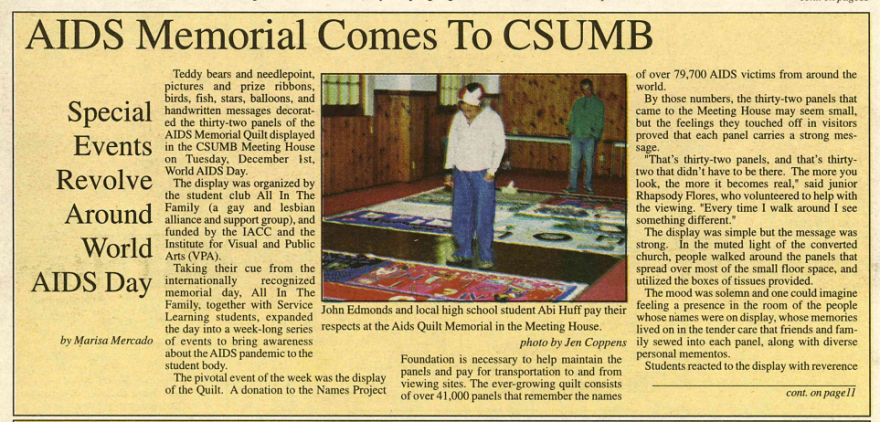Two separate mission statements for Cal State Monterey Bay’s Rainbow Raft Pride Center are immediately visible once stepping through its door and into a space adorned with a litany of pride flags.
One is emblazoned on a poster decorated with rainbow ribbon graphics: The paragraph-length statement declares the center’s intention to promote queer intersectionality, nurture queer and trans communities, provide resources and offer LGBTQ+ educational and cultural programs to promote equality and respect.
And the other, directly next to it, is a two-word rainbow-magnet slogan: “Queer joy!”

Both encompass the goals of the new affinity center, which joins 13 others across the Cal State University system focused on serving LGBTQ+ students. Its official opening is May 8.
The rise of these centers began two years after the Stonewall Uprising, with the Spectrum Center at the University of Michigan founded in 1971. There are over 250 such centers in the United States, helping LGBTQ+ students navigate a landscape that is in some ways, improved from 53 years ago — and in others, still a challenge.
Across the country, over 550 anti-trans bills have been introduced into the legislature this year alone.
Because of that, Athena Burciaga, one of two student coordinators for the center, says she thinks “one of the big civil rights fights now is going to be for trans rights.”
For her, making sure trans students feel welcomed and at home in the center is important. Part of that is visibility — underscoring that queer and trans people “are here, and we do exist.”
“We want to have a space that not only welcomes in openly queer people, but we also want to welcome allies and people that are just discovering their sexual or gender identity,” she said. “And just make it known that, ‘Hey, it's not really weird or abnormal for you to express yourself in this way … You just have to find community [with] other people.’”

In an emailed comment, Cal State Monterey Bay president Vanya Quiñones said the Rainbow Raft Pride Center "is more important than ever."
"We foresee that the Pride center will be a hub of activities that will provide cultural and recreational activities, as well as support to our LGBTQ+ students," she said.
The campus’s LGBTQ+ history hasn’t always been the most visible, added David Reichard, a professor of history and legal studies at Cal State Monterey Bay, who was one of the advisors to the first LGBTQ+ student group on campus.
“For example, in 2000, when California was considering an anti-gay marriage proposition on the ballot, the students here really organized around that,” he recalled. “So I remember tabling with them in the front of the post office. We had events on campus.”
He organized the LGBTQ+ History of Monterey County project that’s now archived in the college library, and worked with Burciaga to help get the center off the ground.
It came together relatively quickly. After CSU Monterey Bay administrators asked the LGBTQ+ staff and faculty affinity group if they were interested in developing an affinity center last fall, Reichard and others in the group reached out to students on the process of developing an affinity center. Other similar centers on campus include El Centro for Latiné students, the Undocu-Success Center and the Helen Rucker Center for Black Excellence.

There’s also the Otter Cross Cultural Center, or OC3, which Reichard cites as the “hub for all this [LGBTQ+ organizing] … work for many years.”
“But in the last couple of years, I think there's been a desire to create specific spaces that then can be linked together,” he said. “We're not operating in isolation, but … specific spaces [can help] so students can find their communities on [a] campus that can be a little bit isolating for some students.”
The one-room center is furnished for those who just want to pop in — or linger. It has a modest queer library with books like Elliot Page’s Pageboy, furniture for relaxing and working in turn, a community billboard, a mini-fridge and a projector. Aside from pride flag decor, there’s queer art hung on the walls — a poster of lesbian cowboys is next to a poster of Frank Ocean.
There’s also a queer history wall making LGBTQ+ history on campus visible from the university’s opening in the 1990s to today.
Reichard compiled the news articles on the queer history wall “to kind of honor those queer ancestors.”
“We're going to recognize that this center exists only because of that history,” he added.

Burciaga says one of her favorite clippings details the AIDS Memorial coming to Cal State Monterey Bay — the community devastation during the initial outbreaks of AIDS reminds her of the importance of celebrating queer and trans elders, especially given the hardships they have endured to survive and experience their own queer joy.
“That’s part of what the center's goal is, to foster community for trans youth and help them and give them the resources in order to become those queer and trans elders,” she said.

That can be social scaffolding or information about resources for gender-affirming care and basic needs.
“For years to come, this is going to be a center that is not going to be dependent on what the staff’s work is as much as it is going to be dependent on what other students put into the center,” she said. “So I really encourage people to come out of their comfort zones, come to the center and share your ideas.”
The center is hosting a grand opening reception with refreshments on May 8 from 12 p.m. to 1 p.m. where attendees can provide feedback about events, resources and programming they’d like to see. It is also taking book donations for the library.
This story was updated on May 8 at 11:45 a.m. to include additional comment from the Cal State Monterey Bay president.
CSU Monterey Bay holds the FCC license for 90.3 KAZU. The station is located on the university’s campus.



